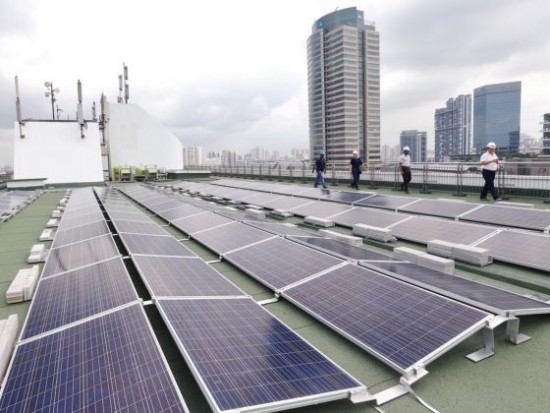The solar power capacity in Singapore has been growing steadfastly over the years, especially since the execution of the SolarNova scheme. In three years, the solar power capacity of Singapore has grown from 33.1 MWp to 129.8 MWp. The unit MWp is mega watt peak, which is a standard measure used in the photovoltaic industry for the nominal power of a unit. The quadrupling of capacity from 2014 to the end of the first quarter of 2017 is the highlight of the report published by the Energy Market Authority on 31st of July. This comes at a time as Singapore is poised to set up the largest floating solar cell in the world at Tengeh Reservoir where more than ten systems will be evaluated for performance and viability.
The seeds of the SolarNova scheme date back to 2010, when the Economic Strategies Committee decided to set a target of meeting 5% of the peak electricity demand in Singapore with renewable energy, including solar power. The deadline chosen was 2020. 5% of the peak electricity demand is 350 MWp, considering the energy consumption back in 2010. Right now, solar power capacity falls short of the halfway mark but if the momentum is kept up then the capacity can quadruple again in the next three years and that would lead to a solar power capacity exceeding 350 MWp. Solar power alone, among renewable energy sources, would be able to meet more than 5% of the peak electricity demand.
The spectacular growth in solar power capacity has been largely contributed to by agencies like the Housing Board, town councils, the private sector and the grassroots units. Housing Board has provided space on rooftops to install solar panels. The town councils have benefited in the process by getting discounts on electricity rates. The private sector has been forthcoming and many nongovernment initiatives have also helped in spreading the word and eventually getting organizations and people to make space for the installation of solar panels. However, there has been very little growth in installation of solar panels atop residential properties.
Solar panel installations in the private sector have contributed 45% and grassroots units & town councils have contributed 44% towards the total newly installed capacity. Both are nonresidential installations. In comparison, there have been less than six hundred installations in the residential sector. This is a cause for concern, albeit not surprising. The cost of installing smaller solar panels is significantly higher when you draw a proportionate comparison with larger panels. Residential rooftops are not ideal for larger panels and there is limited space so it must be optimized meticulously.
The EMA has launched a few initiatives to encourage more residential property owners to consider getting solar panels installed. For instance, it is now much easier for consumers to get paid for generating excess solar power and feeding it to the grid. Experts estimate there will be a considerable drop in costs of solar panels and also the cost of installation. Both factors will make switching to renewable energy more viable and affordable for homeowners and residential developments.
About the Author
Morris Edwards is a content writer at CompanyRegistrationinSingapore.com.sg, he writes different topics like FinTech Startups in Singapore and Singapore’s Economy Is Expected to Grow This Year and all topics related to Business and Economy, if you are interested about Company registration Singapore visit our website.
Contact:
Company: Singapore Company Incorporation Consultants Pte Ltd
Address: 10 Anson Road International Plaza #27-15, Singapore 079903
Telephone: +65 66531211
E-mail: info@companyregistrationinsingapore.com.sg
Website: https://www.companyregistrationinsingapore.com.sg
